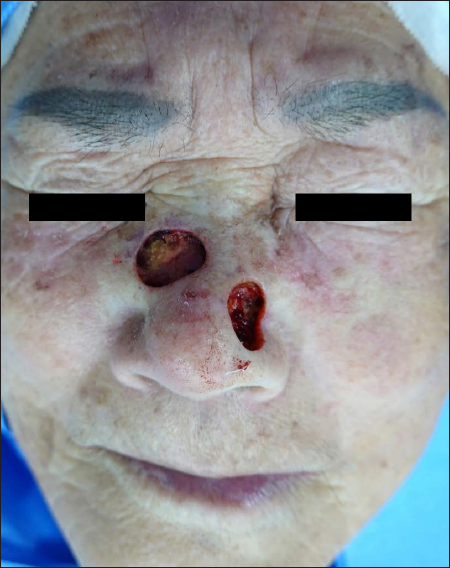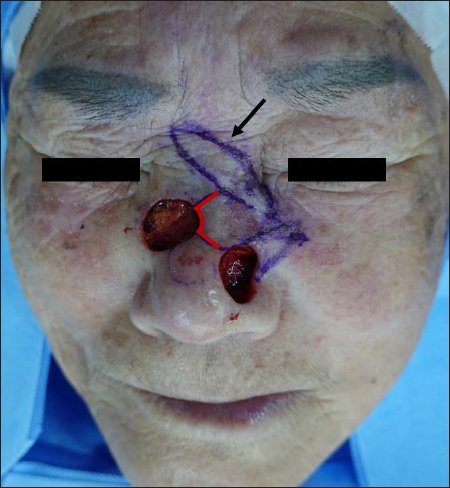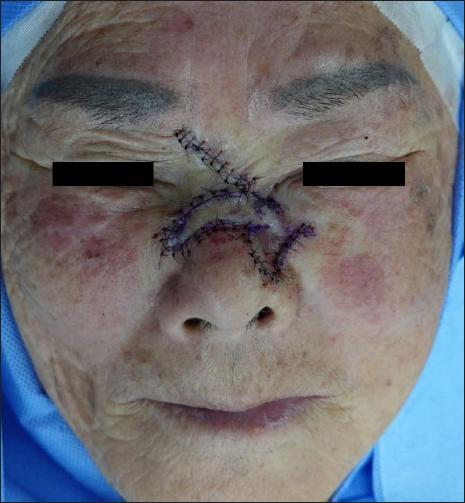Translate this page into:
Swift one-stage reconstruction of two adjacent nasal defects with a modified bilobed flap
Corresponding author: Prof. Jun Young Kim, Department of Dermatology, School of Medicine, Kyungpook National University, Kyungpook National University Hospital, Daegu, South Korea. 198kjy@hanmail.net
-
Received: ,
Accepted: ,
How to cite this article: Lee SH, Kim JY. Swift one-stage reconstruction of two adjacent nasal defects with a modified bilobed flap. Indian J Dermatol Venereol Leprol 2022;88:839-41.
Sir,
The nasal area, which has complex three-dimensional structures, limited mobility and cosmetic importance, is one of the most difficult areas for dermatologic surgery reconstruction. Although a few possible options are noted for reconstructing multiple skin defects,1 those involving two adjacent defects ≥1.5 cm on both sides of the nose are challenging. An interesting case of two adjacent nasal defects, where time-saving simultaneous removal with better aesthetic results, with a modified bilobed flap was achieved, is reported in this study.
An 81-year-old female presented with two basal cell carcinomas measuring 1.0 × 1.0 and 0.9 × 0.9 cm on the right nasal sidewall and left nasoalar crease, respectively [Figure 1a]. The patient reported a previous medical history of hypertension, diabetes mellitus, dyslipidemia and coronary artery disease. A physical examination with neck ultrasonography found no evidence of lymph node metastasis. Wide excision with a lateral margin of 3 mm was performed, resulting in a defect measuring 1.7 × 1.3 and 1.5 × 1.4 on the right nasal sidewall and the left nasoalar crease, respectively [Figure 1b].

- Two adjacent nasal basal cell carcinomas

- Nasal defects: 1.7 × 1.3 cm (right nasal sidewall) and 1.5 × 1.4 cm (left nasal sidewall and ala)
However, these defects not only spanned over various nose subunits (e.g., dorsum, sidewall and alar lobule), leading to difficulties in achieving esthetic reconstruction, but were also close to the lower eyelid, which could pose a risk of ectropion. Additionally, performing a local flap separately for each defect due to the risk of flap failure was difficult because these defects were located too adjacently, and a two-stage excision and skin grafting or local flap was too time-consuming and labour extensive. To address this problem, designing a bilobed flap and using a redundant tip of the second lobe was essential for reconstruction. First, a pivot point of a bilobed flap, where the two lines connecting the centres of each defect and the pivot point meet at 45°, was set (Figure 2a, red dotted lines). The centre of the first lobe of the bilobed flap was located on the line connecting the centres of the right defect and the pivot point. Due to the right defect, the first lobe obtained a modified short design; therefore, it required a notch on the tip (Figure 2b, red solid line), which lengthened and enlarged it, allowing the left lower defect to be sufficiently covered. Second, the lobe was designed to be long enough to reach the glabella, and a sufficiently long incision towards the pivot point of the lateral margin of the second lobe allowed to overcome the shortness of the first lobe (Figure 2b, black arrow). After removing the Burrow’s triangle and undermining the flap, the first lobe covered the lower defect, and the second lobe covered the secondary defect and upper defect at once [Figure 2c]. The flap healed well with a cosmetically good outcome at two months post-surgery [Figure 3].

- A pivot point where the two lines connecting centres of each defect and the pivot point meet at 45°

- A notch on the tip of the first lobe and sufficiently long second lobe was set

- Swift one-stage reconstruction of the two nasal defects was completed with a modified bilobed flap

- A cosmetically good outcome was achieved at two months post-surgery
A bilobed flap is a double transposition flap, usually used for reconstructing defects of the lower third of the nose, where the first and second lobes were transposed into a defect and covered the secondary defect caused by the first flap transposition, respectively.2,3 The second lobe often resulted in redundant tissue after covering the secondary defect because it is often designed with an elliptical tip to facilitate closure.3 This redundant tip was focused on covering another defect, saving the normal skin that is useful in the reconstruction of nose defects, which has complex anatomy with limited tissue reservoirs. Moreover, optional skin grafting using the tissue of Burrow’s triangle is available when the tissue reservoirs are limited. Other advantages of this flap included a cosmetically good outcome with little asymmetry and deformities, and saved time and labour owing to its swift one-stage flap reconstruction. The only barrier is that it can be difficult for the first lobe to reach the distal end of the lower defect, which can be tackled with sufficient flap undermining and incision length of the lateral margin of the second lobe.
Declaration of patient consent
The authors certify that they have obtained all appropriate patient consent.
Financial support and sponsorship
Nil.
Conflict of interest
There are no conflicts of interest.
References
- Simultaneous excision and extemporary skin plastics: New reconstructive techniques after tumor surgery In: Pierre V, ed. Dermatologic surgery and procedures (1st ed.). London: InTechOpen; 2018. p. :77-98. In ed.
- [CrossRef] [Google Scholar]
- A modified bilobed flap design for nasal tip defects. Plast Aesthet Res. 2014;1:16.
- [CrossRef] [Google Scholar]
- The Zitelli’s bilobed flap in ala and nasal tip reconstruction. J Med Res. 2016;2:163-5.
- [CrossRef] [Google Scholar]





